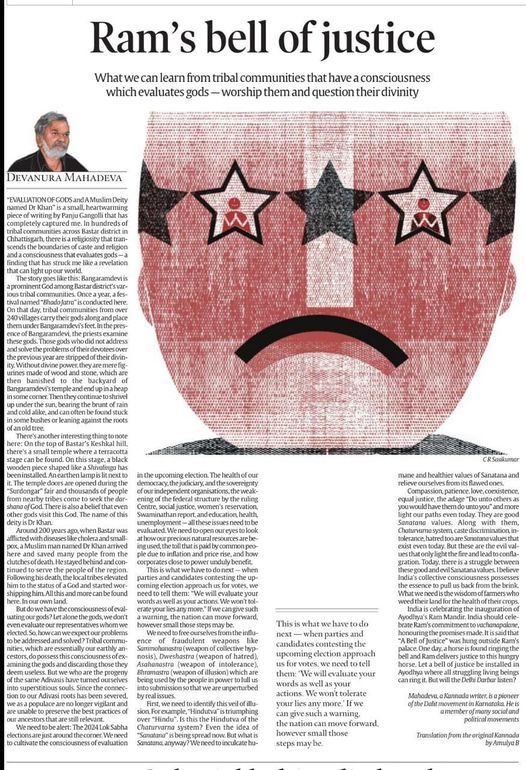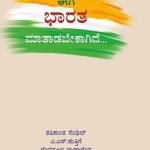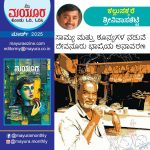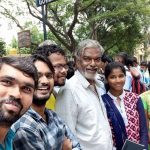Evaluating Tribal Deities and Rama’s Bell of Justice-Devanura Mahadeva
[An extended version of Devanur Mahadeva’s article, published in the analysis section of Prajavani on 20.1.2024, translated into English by Amulya.B and published in the Indian Express on 9.2.2024. ಪ್ರಜಾವಾಣಿ ಪತ್ರಿಕೆಯ ವಿಶ್ಲೇಷಣೆ ವಿಭಾಗದಲ್ಲಿ 20.1.2024ರಂದು ಪ್ರಕಟವಾದ ದೇವನೂರ ಮಹಾದೇವ ಅವರ ಲೇಖನದ ವಿಸ್ತೃತ ರೂಪವಾದ, “ಆದಿವಾಸಿ ದೈವಗಳ ಮೌಲ್ಯಮಾಪನ ಹಾಗೂ ಶ್ರೀರಾಮನ ನ್ಯಾಯದ ಗಂಟೆ” ಲೇಖನವು ಅಮೂಲ್ಯ.ಬಿ ಅವರಿಂದ ಇಂಗ್ಲಿಷ್ ಗೆ ಅನುವಾದಗೊಂಡು 9.2.2024ರ ಇಂಡಿಯನ್ ಎಕ್ಸ್ಪ್ರೆಸ್ ಪತ್ರಿಕೆಯಲ್ಲಿ ಪ್ರಕಟಗೊಂಡಿದೆ.]
https://indianexpress.com/…/rams-bell-of-justice…/
‘Evaluation of Gods and A Muslim Deity named Dr. Khan’ is a small, heartwarming piece of writing by Panju Gangolli that has completely captured me. In hundreds of tribal communities across Bastar district in Chattisgarh, there is a religiosity that transcends the boundaries of caste and religion and a consciousness that evaluates Gods – a finding that has struck me like a revelation that can light up our world.
The story goes like this: Bangaramdevi is a prominent God among the Bastar district’s various tribal communities. Once a year, a festival named ‘Bhado Jatra’ is conducted here. On that day, tribal communities from over 240 villages carry their Gods along and place them under Bangaramdevi’s feet. In the presence of Bangaramdevi, the priests examine these Gods. Those
Gods who did not address and solve the problems of their devotees over the previous year are stripped off of their divinity. Without divine power, they are mere figurines made of wood and stone which are then banished to the backyard of Bangaramdevi’s temple and end up in a heap in some corner. Then they continue to shrivel up under the sun, bearing the brunt of rain and cold alike, and can often be found stuck in some bushes or leaning against the roots of an old tree.
There’s another interesting thing to note here: on the top of Bastar’s Keshkal hill, there’s a
small temple where a terracotta stage can be found. On this stage, a black wooden piece shaped like a Shivalinga has been installed. An earthen lamp is lit next to it. The temple doors are opened during the ‘Surdongar’ fair and thousands of people from nearby tribes come to seek the darshana of God. There is also a belief that even other Gods visit this God. The name of this deity is Dr.Khan.
Around 200 years ago, when Bastar was afflicted with diseases like Cholera and Smallpox, a Muslim man named Dr. Khan arrived here and saved many people from the clutches of death. He stayed behind and continued to serve the people of the region. Following his death, the local tribes elevated him to the status of a God and started worshipping him. All this and more can be found here. In our own land.
But do we have the consciousness of evaluating our Gods? Let alone the Gods, we don’t even evaluate our representatives whom we elected. So, how can we expect our problems to be addressed and solved? Tribal communities which are essentially our earthly ancestors do possess this consciousness of examining the Gods and discarding those they deem useless. But, we who are the progeny of the same adivasis have turned ourselves into superstitious souls. Since the connection to our Adivasi roots has been severed, we as a populace are no longer vigilant and are unable to preserve the best practices of our ancestors that are still relevant.
We should wake up at least now and evaluate our present parliamentary representatives at the feet of the voters. If that were to ever happen, I believe we would have to throw out at least 90% of the MPs from the Parliament. We need to be alert: the 2024 Lok Sabha elections are just around the corner. We need to cultivate the consciousness of evaluation in the upcoming election. The health of our democracy, the judiciary, and the sovereignty of our independent organisations, the weakening of the federal structure by the ruling centre, social justice, women’s reservation, Swaminathan report, and education, health, unemployment – all these issues need to be evaluated. We need to open our eyes to look inside the wealth of the capitalists close to the Prime Minister: the wealth which grew multifold even during the precarious period of Covid-19. Our precious natural resources as well as the toll that is paid by the common people due to inflation and price rise are lining the pockets of these capitalists close to power. Only if this golmaal is stopped, can India be saved.
This is what we have to do next – when the parties and candidates contesting the upcoming election approach us for votes, we need to tell them this: ‘We will evaluate your words as well as your actions. We won’t tolerate your jumlas(lies) any more’. If we can give such a warning, the nation can move forward, however small those steps may be. We need to free ourselves from the influence of fraudulent weapons like Sammohanastra (weapon of collective hypnosis), Dweshastra (weapon of hatred), Asahanastra (weapon of intolerance), Bhramastra (weapon of illusion) which are being used by the people in power to lull us into submission so that we are unperturbed by real issues. Only then can we evaluate our representatives properly.
First, we need to identify this veil of illusion. For example, the bugle of Hindutva is being blown
systematically. Now, ‘Hindutva’ is triumphing over ‘Hindu’. For example: we use the word ‘I’. This is required for identification. But what is this ‘I-ness’? This essentializing is an excess used only to dominate others. Similarly words like ‘Hindu’ and ‘Hindusthani’ are identifying words. But the Hindutva of the Chaturvarna system? It is a destructive, excess force, similar to the ‘I-ness’. It takes us to a place where only ‘I, my and mine’ remains and nothing else. But as our puranas, history and epics have shown, where this ‘I-ness’ crosses a limit, this hubris is consistently destroyed (garvabhanga). When Bhima became hubristic about his strength, he couldn’t move Hanuma’s tail. Whenever something crosses limits, it will be brought down eventually. This has always been part of India’s collective consciousness.
Even the idea of ‘Sanatana’ is being spread now. Society is becoming rigid by polluting the waters of social harmony. No one is letting it settle. But what is Sanatana, anyway? These are the values which have travelled with us from ancient times to the present. It has both good and flawed values. While the communities of Basthar have relevant values such as the evaluation of Gods they may also have many flawed ones. In such circumstances, anyone saying ‘accept my Sanatana Dharma’ can only mean accept my flaws as well.
However, we need to inculcate humane and healthier values of Sanatana and relieve ourselves from its flawed ones. For example, compassion, patience, love, coexistence, equal justice, the adage ‘Do unto others as you would have them do unto you’ and more light our paths even today. They are good Sanatana values. Along with them, Chaturvarna system, caste discrimination, intolerance, hatred too are Sanatana values which exist even today. But, these are the evil values that only light the fire and lead to conflagration. Today, there is a struggle between these good and evil Sanatana values. Those who are busy in this struggle do not have the consciousness to evaluate our representatives. Despite all this, I believe India’s collective consciousness possesses the essence to pull us back from the impending doom. What we need is the wisdom of farmers who weed their land for the health of their crops.
Right now, India is celebrating the inauguration of Ayodhya’s Rama Mandira. Instead, India should have celebrated Rama’s commitment to vachanapalane, honour the promises made. But, this vachanapalane not visible anywhere in Rama’s land. In the hinterlands, a few Rama Mandiras have become gambling dens too. The politics rooted in gambling shouldn’t have infected Rama Mandira.
It is said that “A Bell of Justice” was hung outside Rama’s palace. One day, a horse is found ringing the bell and Rama delivers justice to this hungry horse. India too needs a fair person with eyes, ears, and heart to lead this land, and soon. Let a bell of justice be installed in Ayodhya where all struggling living beings can ring it. But, will the Delhi Darbar listen?
Translation from the original Kannada: Amulya B








